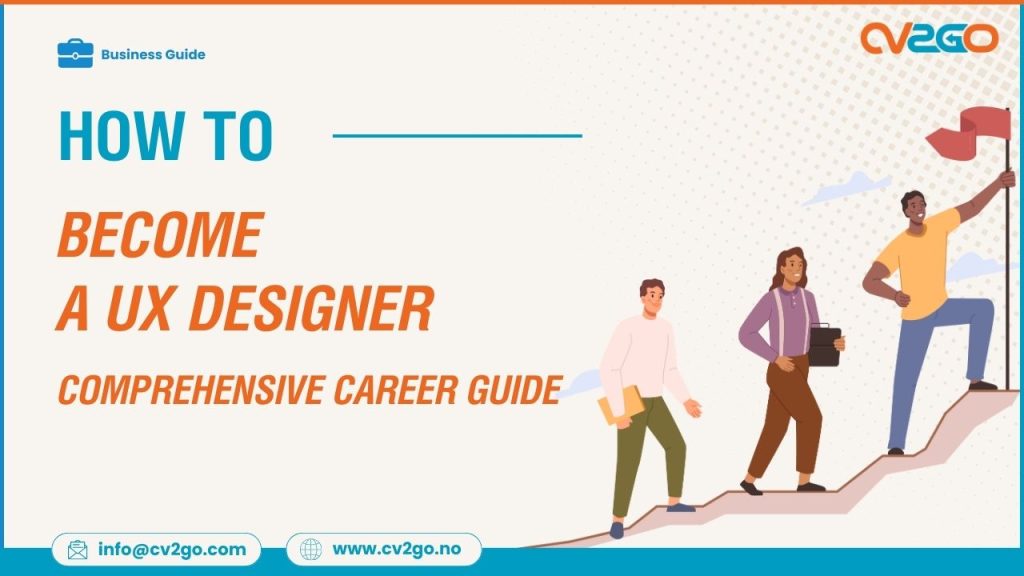When a digital product or service exceeds your expectations, it’s likely the work of a skilled UX designer. These professionals ensure that navigating a website, scrolling through an app, or purchasing a product is seamless and satisfying. By addressing user needs, UX designers create intuitive, engaging experiences that leave a lasting impression. This career is at the intersection of creativity, problem-solving, and technology, offering both personal satisfaction and professional growth opportunities.
If you’re curious about how to become a UX designer but don’t know where to begin, this guide is for you. From essential skills and education to career prospects and day-to-day responsibilities, we cover everything you need to determine if this profession is right for you.
What is a UX Designer?
UX stands for User Experience, and a UX designer’s role is to craft and enhance interactions between users and products or services. They place the needs and expectations of users at the center of their process, aiming to create intuitive, engaging, and functional designs that are not only visually appealing but also highly practical and efficient.
By blending research, psychology, design principles, and technical knowledge, UX designers identify pain points in user journeys and generate solutions. Their work ensures that products not only meet user needs but also foster satisfaction and loyalty, driving long-term user engagement.
What Does a UX Designer Do?
A UX designer’s primary responsibility is to view a product through the lens of its target audience, addressing their needs to create positive and intuitive experiences. Key tasks include:
- Conducting user research through interviews, surveys, and usability tests to gather insights into user behavior and preferences.
- Synthesizing research data into user personas and scenarios that guide the design process.
- Designing information architecture to organize and structure content for better navigation and comprehension.
- Creating wireframes and prototypes to map out product layouts, functionality, and interactions, ensuring alignment with user expectations.
- Collaborating with UI designers, developers, and product managers to ensure cohesive and functional designs that align with project goals.
- Monitoring post-launch performance to identify areas for improvement and implement updates as needed to enhance user satisfaction.
In addition to these tasks, UX designers often address technical challenges, work with emerging technologies, and continually adapt their designs to evolving user expectations. Continuous learning and adaptation are integral to their role, ensuring that they remain relevant in a fast-paced industry.
How to Become a UX Designer
Educational Requirements and Learning Paths
Becoming a UX designer requires a combination of theoretical knowledge, practical skills, and software proficiency. While a formal degree isn’t mandatory, relevant degrees in graphic design, computer science, or visual communication can be advantageous. Alternatively, you can:
- Learn through free or paid online courses, such as those offered by platforms like Coursera, edX, or LinkedIn Learning.
- Attend workshops or boot camps focused on UX design methodologies, providing hands-on training and mentorship.
- Self-study using books, tutorials, and case studies to build foundational knowledge and practical skills.
Topics to focus on include user research, information architecture, wireframing, prototyping, and usability testing. Additionally, familiarize yourself with design tools like Figma, Sketch, Adobe XD, and prototyping platforms such as InVision and Axure RP.
Building a Portfolio
A strong portfolio is essential for showcasing your skills and design process. Include case studies highlighting:
- The problem you aimed to solve and its significance.
- Your research and design methodology, including tools and techniques used.
- Wireframes, prototypes, and final designs, demonstrating the evolution of your work.
- Results and user feedback post-implementation, showcasing the impact of your designs.
Practical experience—whether through internships, freelance work, or personal projects—adds significant value to your portfolio. Additionally, consider creating a personal website to display your portfolio and provide a professional touch.
How Long Does It Take to Become a UX Designer?
The time it takes to become a UX designer depends on your background, learning approach, and dedication. Here are typical timelines:
- With Prior Experience: If you have a background in design or a related field, transitioning to UX design may take 3 to 6 months with focused learning and practice.
- Without Prior Experience: For beginners, it can take 6 months to 2 years to acquire the necessary skills and build a portfolio through consistent effort.
- Formal Education: Pursuing a degree can take 2 to 4 years but provides comprehensive training, a strong network, and credentials that enhance employability.
A Day in the Life of a UX Designer
A UX designer’s day involves a mix of collaboration, research, design, and refinement. Typical tasks include:
- Morning: Review project goals and attend team meetings with product managers, developers, and other stakeholders. Collaborate on project timelines and deliverables.
- Midday: Conduct user research, analyze data, and synthesize insights to inform design decisions. This may include creating user personas and mapping out user journeys.
- Afternoon: Create wireframes, prototypes, and usability tests. Analyze test results to refine designs and enhance usability. Collaborate with developers to ensure design feasibility.
- Evening: Update documentation, review feedback from stakeholders, and prepare for the next day’s tasks. Engage in self-learning or skill development to stay updated with industry trends.
Continuous learning is a vital part of a UX designer’s routine, as industry trends, technologies, and user expectations evolve rapidly. Staying informed ensures your designs remain relevant and effective.
UX Designer Salary: How Much Do UX Designers Make?
Average Salary
As of 2024, the average annual salary for UX designers in the United States is $76,429. Entry-level designers earn around $24,000 to $93,000 annually, while experienced designers can earn up to $154,000. Salaries vary significantly based on location, company size, and specialization.
Hourly Wages
Hourly rates vary based on experience and location. For example:
- Entry-Level: $20 to $45 per hour.
- Mid-Level: $45 to $70 per hour.
- Senior-Level: $70 to $100+ per hour.
Freelancers often have greater flexibility in setting their rates, with experienced professionals commanding premium prices for specialized services.
Is UX Design a Good Career Choice?
UX design is an excellent career for individuals who:
- Enjoy solving complex problems and thrive in creative environments.
- Have a strong interest in design and technology, coupled with a willingness to learn continuously.
- Possess excellent communication and collaboration skills, as teamwork is integral to the role.
- Are adaptable and open to feedback, ensuring their designs meet user and business needs.
The demand for UX designers spans various industries, offering opportunities for career growth, financial stability, and the chance to make a tangible impact on user experiences.
Industries That Employ UX Designers
UX designers are in high demand across multiple sectors, including:
- Technology: Designing software and applications for improved user engagement.
- E-commerce: Enhancing online shopping experiences to boost sales and customer satisfaction.
- Healthcare: Creating user-friendly medical platforms that simplify complex processes.
- Education: Developing engaging e-learning tools that cater to diverse learning needs.
- Government: Improving access to public services and creating intuitive digital solutions.
Freelance opportunities also abound, allowing UX designers to work on diverse projects across multiple industries while enjoying flexibility and autonomy.
How to Apply for UX Designer Jobs
Crafting a Resume and Portfolio
Use CV2Go’s resume templates to create an ATS-friendly UX designer resume. Highlight:
- Key skills, such as user research, wireframing, and prototyping.
- Relevant experience and certifications that showcase your expertise.
- Notable projects and their outcomes, emphasizing measurable results.
Pair your resume with a polished portfolio that showcases your design process, problem-solving abilities, and the impact of your work.
Preparing for Interviews
- Research the company, its products, and its target audience to tailor your responses.
- Practice discussing your design rationale and problem-solving approach with clarity and confidence.
- Be ready to showcase your portfolio, explain specific projects, and discuss challenges and solutions in depth.
Frequently Asked Questions (FAQs)
Do I Need a Degree to Become a UX Designer?
No, a degree is not mandatory. Online courses, boot camps, and self-learning can equip you with the skills needed to enter the field.
What Tools Should I Learn?
Popular tools include Figma, Sketch, Adobe XD, InVision, and Axure RP. Mastering these tools enhances your efficiency and versatility.
How Long Does It Take to Become a UX Designer?
It can take 6 months to 2 years, depending on your background and learning pace.
What Makes a Good UX Designer?
A good UX designer combines technical expertise with empathy, problem-solving skills, and effective communication. They stay updated with industry trends and are adaptable to changing user needs.
Final Takeaway
Becoming a UX designer is a rewarding journey filled with opportunities to create meaningful user experiences. By acquiring the right skills, building a strong portfolio, and using CV2Go’s professional resume templates, you can position yourself for success in this dynamic field.
Are you ready to start your UX design career? Build your resume today with CV2Go and take the first step toward an exciting and fulfilling profession.




